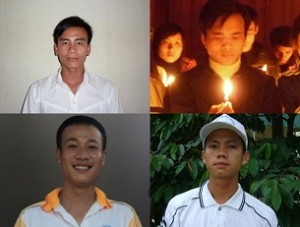Last line of Defence - Tuyến Phòng Thủ Cuối Cùng
Featured
-
Open letter to Diplomatic Missions of the democratic countries in Vietnam
-
Thư ngỏ của gia đình TNLT Trịnh Bá Phương gửi phái bộ ngoại giao các nước dân chủ
-
Imprisoned activist Trinh Ba Phuong charged for writing ‘down with communism’
-
TNLT Trịnh Bá Phương bị khởi tố khi đang thi hành án tù mười năm
-
Một thương binh bị bắt vì giúp người dân khiếu kiện
-
Thành viên thứ hai của Tập hợp Dân chủ Đa nguyên bị bắt tạm giam
-
Tù nhân chính trị ở Trại giam Xuân Lộc kêu cứu vì bị bỏ đói
Recent Comments
-
Height Insoles: Hi, I do believe this is an excellent site. I stumbledupon …
-
http://fishinglovers.net: Appreciate you sharing, great post.Thanks Again. Keep writi…
-
Achilles Pain causes: Every weekend i used to pay a quick visit this site, as i w…
Powered by WordPress • Themify WordPress Themes






June 29, 2017
U.S. State Dept Says Vietnam’s Anti-Human Trafficking Efforts Still Lacking
by Nhan Quyen • [Human Rights]
by VP, June 29, 2017
Although Vietnam’s government has made great efforts in its fight against human trafficking, it still failed to meet the minimum standards in several key areas, the VOA news outlet reported on June 29, citing the Trafficking in Persons Report 2017 recently released by the U.S. Department of State.
Given this assessment, Vietnam remained on Tier 2 in the classification of human trafficking elimination in 2016.
During the year, the country reported identifying 1,128 victims—an increase from 1,000 in 2015 and 1,031 in 2014—but did not provide statistics disaggregating identified cases by type of trafficking, victim age or gender, source, or destination.
Informally, officials from the Ministry of Public Security estimated 85% of identified cases involved transnational trafficking. Last year, the government reported assisting about 600 victims, a slight decrease from 650 in 2015 and 668 in 2014.
According to the report, the Vietnamese government has demonstrated increasing efforts to identify more victims; expand anti-trafficking training for law enforcement, local government officials and members of vulnerable communities and issue guidelines to relevant ministries and provincial authorities on the national anti-trafficking action plan.
However, anti-trafficking efforts were implemented by a lack of interagency coordination among provincial officials with anti-trafficking legislation and victim identification procedures.
Additionally, the implementation of the amended 2015 Penal Code, including new anti-trafficking articles, continued to be delayed, leaving deficiencies in the law that hindered interagency coordination and law enforcement efforts.
Victim protection services remained under-resourced and poorly integrated into referral mechanisms; authorities did not actively screen for trafficking among vulnerable groups or systematically refer victims to care.
The report also gave some recommendations on anti-human trafficking for Vietnam, including:
(1) Fully enact and implement articles 150 and 151 of the new Penal Code; vigorously prosecute all forms of trafficking and convict and punish traffickers;
(2) Finalize and conduct the national victim survey in order to improve victim referral mechanisms and services;
(3) Improve interagency cooperation to effectively implement the anti-trafficking national plan of action;
(4) Develop programs that reduce stigma and promote reintegration of trafficking returnees;
(5) Fully implement the ASEAN Convention against Trafficking in Persons, especially Women and Children.